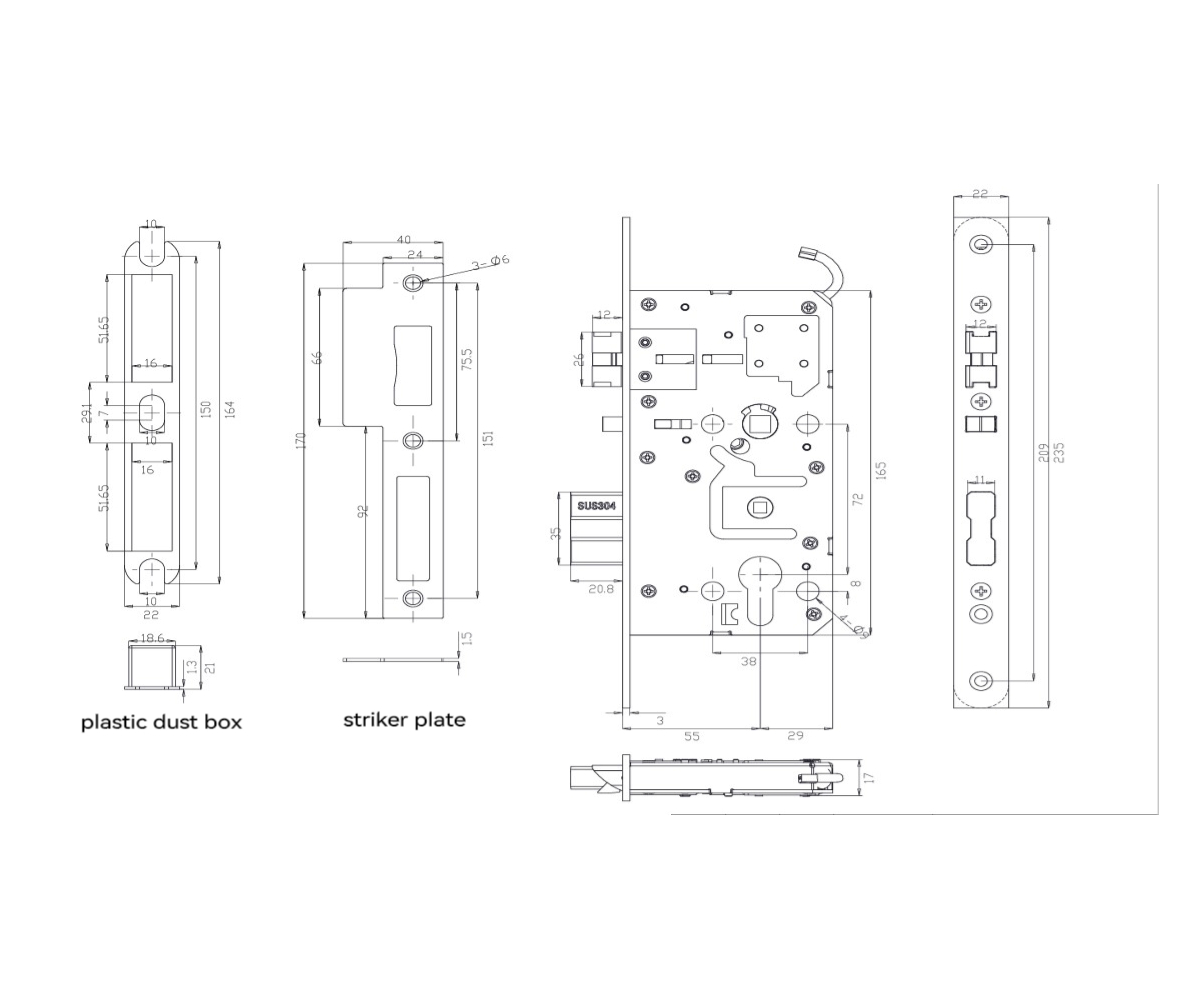Commercial door locks endure constant use, weather exposure, and general wear that can compromise security over time. When your business's lock starts showing signs of malfunction or damage, replacing it promptly protects your property and ensures smooth operations.
Replacing a commercial door lock might seem daunting, but with the right tools and approach, many business owners can handle this task themselves. However, the complexity depends on your lock type and door configuration. This guide walks you through the entire process, from assessing your current lock to installing a new one.
Before starting any work, consider whether this is a DIY project or requires professional assistance. Simple cylinder replacements are often manageable, while complex electronic systems or high-security installations typically need expert attention.
Assessing Your Current Commercial Door Lock
The first step involves identifying what type of commercial door lock you currently have. Common types include mortise locks, cylindrical locks, deadbolts, and electronic access systems. Each requires different replacement approaches.
Examine your lock's condition carefully. Look for obvious signs of damage like bent keys, sticky mechanisms, loose handles, or visible wear around the keyway. Sometimes the issue is just a worn cylinder that can be replaced without changing the entire lock assembly.
Check your door's thickness and existing holes. Commercial doors typically range from 1.75 to 2.25 inches thick, and hole measurements must match your new lock specifications. Measure the backset distance—the space between the door edge and the center of the lock cylinder—as this affects which replacement locks will fit properly.
Document any existing security features or access control integrations. If your current lock connects to an alarm system or master key system, your replacement must maintain these capabilities.
Tools and Materials You'll Need
Gather these essential tools before beginning your commercial door lock replacement:
Basic Tools:
· Screwdrivers (both Phillips and flathead)
· Electric drill with various bit sizes
· Measuring tape
· Level
· Pencil for marking
· Utility knife
· Chisel set
· Hammer
Specialized Items:
· Lock installation kit (if available for your lock brand)
· Door lock jig for precise hole alignment
· Hole saw attachments for drilling
· Metal file for smoothing rough edges
Safety Equipment:
· Safety glasses
· Work gloves
· Drop cloths to protect flooring
Purchase your replacement commercial door lock before starting removal. Bring measurements and photos of your current setup to ensure compatibility. Consider upgrading to higher security grades or adding features like anti-drill plates or reinforced strike plates.

Removing the Old Lock
Start by unlocking and opening the door to access both sides easily. Remove any decorative trim or covers that might conceal screws or mounting hardware.
For cylindrical locks, locate the screws on the interior side of the door that hold the lock mechanism together. Remove these screws and carefully pull the lock halves apart. The cylinder should come out toward the interior side.
Mortise locks require removing the interior trim first, then unscrewing the lock body from inside the door edge. These locks slide out from the door edge rather than pulling through the door face.
If you encounter resistance during removal, check for hidden screws or clips. Some commercial locks have security features that prevent easy removal without proper tools or techniques.
Clean the door thoroughly after removing the old hardware. Remove any debris, old lubricant, or metal shavings from the holes and door edge. This ensures your new lock fits properly and operates smoothly.
Installing Your New Commercial Door Lock
Begin installation by test-fitting your new lock components before final assembly. This helps identify any issues while corrections are still easy to make.
For most commercial door locks, start with the exterior components. Insert the cylinder or lock body according to the manufacturer's instructions, ensuring proper orientation. The keyway should be positioned correctly, and any mounting tabs should align with your door's existing holes.
Thread the connecting screws or tailpiece through to the interior side, then attach the interior hardware. Tighten screws gradually and evenly to avoid binding the mechanism or cracking the door material.
Install the strike plate on the door frame, ensuring proper alignment with the lock bolt. The strike plate might require slight adjustments to existing mortises or completely new cuts, depending on your old and new lock specifications.
Test the lock operation multiple times before considering the job complete. The key should turn smoothly, the bolt should extend and retract fully, and the door should close and latch properly without binding.
Testing and Troubleshooting
After installation, perform comprehensive testing to ensure your new commercial door lock functions correctly. Test locking and unlocking from both sides, check that keys turn smoothly without excessive force, and verify that the bolt extends fully into the strike plate.
Common issues include misaligned strike plates, overtightened screws causing binding, or incorrect backset measurements. If the key is hard to turn, check that the cylinder is properly seated and that connecting hardware isn't twisted or misaligned.
Electronic locks require additional testing of batteries, programming, and any connected systems. Verify that backup key access works and that electronic components respond properly to programming attempts.
If you encounter problems beyond simple adjustments, consider consulting a professional locksmith. Complex issues or security concerns warrant expert attention to ensure your business remains properly protected.
When to Call a Professional
While many commercial door lock replacements are manageable DIY projects, certain situations require professional expertise. High-security installations, master key systems, and access control integrations typically need specialized knowledge and tools.
If your door frame requires significant modification, existing holes don't align with standard replacement options, or you're dealing with fire-rated doors with specific compliance requirements, professional installation ensures proper function and maintains necessary certifications.
Emergency situations where security has been compromised also warrant immediate professional attention rather than attempting DIY repairs that might leave your business vulnerable.
Maintaining Your New Lock
Regular maintenance extends your new commercial door lock's lifespan and ensures reliable operation. Apply appropriate lubricant to moving parts every six months, using graphite for key cylinders and light machine oil for other mechanisms.
Check mounting screws periodically for looseness, especially during the first few months after installation when settling may occur. Tighten as needed, but avoid over-tightening which can cause binding.
Keep spare keys in secure locations and consider having additional copies made while your lock is new and operating smoothly. This prevents future lockout situations and provides backup access for authorized personnel.
Securing Your Investment
Replacing a commercial door lock represents an investment in your business security and operations. Proper installation, regular maintenance, and prompt attention to any issues ensure this investment provides maximum value and protection.
Consider upgrading other security elements like door frames, hinges, and lighting to complement your new lock. A comprehensive approach to security creates multiple layers of protection that work together effectively.
Document your installation with photos and keep all warranty information and spare keys in a secure, accessible location. This preparation helps with future maintenance and any warranty claims that might arise.
Commercial Door Lock
ANSI/BHMA certified commercial lock
commercial lock
English
العربية
Français
Русский
Español
Português
Deutsch
italiano
日本語
한국어
Nederlands
Tiếng Việt
ไทย
Polski
Türkçe
አማርኛ
ພາສາລາວ
ភាសាខ្មែរ
Bahasa Melayu
ဗမာစာ
தமிழ்
Filipino
Bahasa Indonesia
magyar
Română
Čeština
Монгол
қазақ
Српски
हिन्दी
فارسی
Kiswahili
Slovenčina
Slovenščina
Norsk
Svenska
українська
Ελληνικά
Suomi
Հայերեն
עברית
Latine
Dansk
اردو
Shqip
বাংলা
Hrvatski
Afrikaans
Gaeilge
Eesti keel
Māori
සිංහල
नेपाली
Oʻzbekcha
latviešu
অসমীয়া
Aymara
Azərbaycan dili
Bamanankan
Euskara
Беларуская мова
भोजपुरी
Bosanski
Български
Català
Cebuano
Corsu
ދިވެހި
डोग्रिड ने दी
Esperanto
Eʋegbe
Frysk
Galego
ქართული
guarani
ગુજરાતી
Kreyòl ayisyen
Hausa
ʻŌlelo Hawaiʻi
Hmoob
íslenska
Igbo
Ilocano
Basa Jawa
ಕನ್ನಡ
Kinyarwanda
गोंगेन हें नांव
Krio we dɛn kɔl Krio
Kurdî
Kurdî
Кыргызча
Lingala
Lietuvių
Oluganda
Lëtzebuergesch
Македонски
मैथिली
Malagasy
മലയാളം
Malti
मराठी
ꯃꯦꯇꯥꯏ (ꯃꯅꯤꯄꯨꯔꯤ) ꯴.
Mizo tawng
Chichewa
ଓଡ଼ିଆ
Afaan Oromoo
پښتو
ਪੰਜਾਬੀ
Runasimi
Gagana Samoa
संस्कृत
Gaelo Albannach
Sepeti
Sesotho
chiShona
سنڌي
Soomaali
Basa Sunda
Wikang Tagalog
Тоҷикӣ
Татарча
తెలుగు
ትግንያውያን
Xitsonga
Türkmençe
संस्कृत
ئۇيغۇرچە
Cymraeg
isiXhosa
ייִדיש
Yorùbá
isiZulu





































